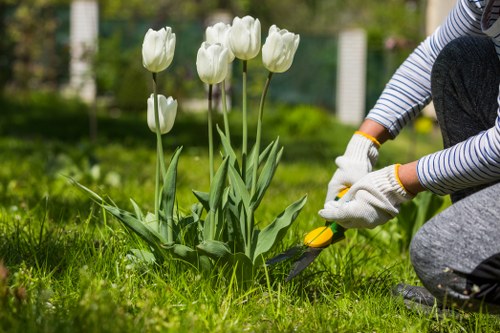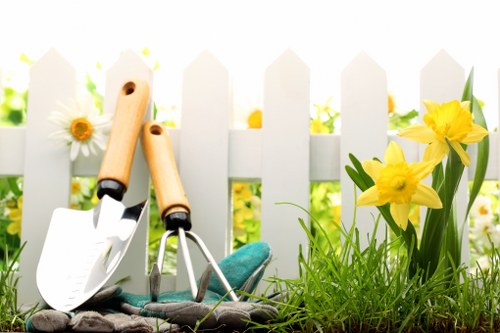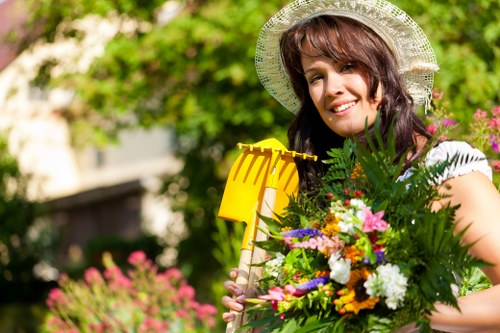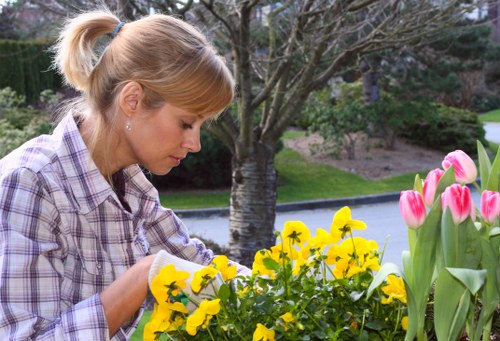Gardener Leaves Green: Embracing Sustainable Practices for a Thriving Garden

Gardening is more than just a hobby; it's a passion that connects us with nature, providing both beauty and sustenance. One essential aspect of successful gardening is ensuring that your plants, especially the leaves, remain green and healthy throughout the growing season. "Gardener Leaves Green" explores the best practices, tips, and sustainable methods to maintain vibrant foliage in your garden.
Healthy green leaves are a sign of a thriving plant. They indicate that the plant is efficiently photosynthesizing, converting sunlight into energy for growth. Achieving and maintaining green leaves requires a combination of proper care, understanding plant needs, and adopting eco-friendly gardening techniques.
In this article, we will delve into the various factors that influence leaf health, including soil quality, watering practices, sunlight exposure, and pest management. We will also highlight some of the closest areas to Leaves Green that offer unique features beneficial to gardeners.
The Importance of Green Leaves in Gardening

Green leaves are not just aesthetically pleasing; they play a critical role in the plant's overall health and growth. Through the process of photosynthesis, leaves convert sunlight into energy, which is vital for the plant's survival and productivity. Healthy green leaves ensure that plants can produce the necessary energy to thrive, resist diseases, and produce flowers and fruits.
Maintaining green leaves is also an indicator of proper care and optimal growing conditions. It reflects that the plant is receiving the right amount of nutrients, water, and sunlight. Conversely, yellowing or browning leaves can signal underlying issues such as nutrient deficiencies, overwatering, or pest infestations.
Therefore, understanding how to keep your leaves green is essential for any gardener aiming to cultivate a lush and healthy garden.
Soil Quality and Its Impact on Leaf Health

The foundation of any healthy garden is the soil. Good soil provides the necessary nutrients and support for plants to grow strong and vibrant. To maintain green leaves, it's crucial to ensure that your soil is well-amended and rich in essential nutrients.
Here are some key aspects of soil quality:
- Nutrient-Rich: Plants require various nutrients like nitrogen, phosphorus, and potassium to develop healthy green leaves. Incorporating compost or organic fertilizers can enhance soil fertility.
- Proper Drainage: Soil should drain well to prevent waterlogging, which can lead to root rot and hinder nutrient uptake.
- pH Balance: Most plants prefer slightly acidic to neutral soil pH. Testing and adjusting the pH can ensure optimal nutrient availability.
- Soil Structure: Good soil structure allows roots to penetrate easily and access air and water efficiently.
Regularly testing your soil and making necessary amendments can significantly improve leaf health and overall plant vigor.
Optimal Watering Practices for Vibrant Leaves

Watering is a critical factor in maintaining green leaves. Both overwatering and underwatering can stress plants, leading to discoloration and reduced growth. Here are some tips for effective watering:
- Consistent Schedule: Establish a regular watering routine based on the specific needs of your plants and the climate.
- Deep Watering: Water deeply to encourage strong root systems, which in turn support healthy leaf growth.
- Mulching: Applying mulch helps retain soil moisture, reducing the frequency of watering and preventing soil temperature fluctuations.
- Check Soil Moisture: Use a moisture meter or simply feel the soil to determine when it's time to water, avoiding both dry and soggy conditions.
Proper watering ensures that plants can absorb the necessary nutrients and maintain their vibrant green foliage.
Sunlight Exposure: Balancing Light for Leaf Health

Sunlight is the primary source of energy for plants through photosynthesis. However, the amount and intensity of sunlight required can vary depending on the plant species. Ensuring that your plants receive the appropriate amount of light is essential for maintaining green leaves.
- Full Sun: Plants that thrive in full sun require at least 6-8 hours of direct sunlight daily. Examples include tomatoes, peppers, and sunflowers.
- Partial Shade: Some plants prefer dappled light or partial shade, receiving around 3-6 hours of sunlight. Examples include hostas and ferns.
- Full Shade: Shade-tolerant plants need less than 3 hours of direct sunlight and can prosper in understory conditions, like certain ivy species.
Understanding the light requirements of your plants and positioning them accordingly will promote healthy, green leaves.
Pest Management: Protecting Your Green Leaves
Pests can cause significant damage to plants, affecting leaf health and overall plant vitality. Effective pest management is crucial for maintaining green foliage.
- Regular Inspection: Frequently check plants for signs of pests, such as holes, discoloration, or sticky residues.
- Natural Predators: Encourage beneficial insects like ladybugs and lacewings that prey on common garden pests.
- Organic Remedies: Use neem oil, insecticidal soaps, or homemade sprays to deter and eliminate pests without harming the environment.
- Proper Sanitation: Remove dead or diseased plant material to prevent pest infestations.
Implementing these pest management strategies will help protect your plants' green leaves and ensure a healthy garden.
Sustainable Gardening Practices for Longevity
Adopting sustainable gardening practices not only benefits your plants but also the environment. Sustainable methods promote long-term garden health and reduce the need for harmful chemicals.
- Composting: Creating compost from kitchen scraps and garden waste enriches the soil with essential nutrients.
- Rainwater Harvesting: Collecting rainwater for irrigation conserves water and provides plants with natural moisture.
- Crop Rotation: Rotating plant species each season prevents soil depletion and reduces pest buildup.
- Integrated Pest Management (IPM): Combining biological, cultural, and mechanical control methods minimizes pest impact sustainably.
By integrating these sustainable practices, gardeners can maintain green leaves and a flourishing garden for years to come.
Understanding the Closest Areas to Leaves Green
For those living near Leaves Green, there are several neighboring areas that offer unique features beneficial to gardeners. These areas provide additional resources, community support, and diverse plant varieties to enhance your gardening experience.
- Maple Grove: Located just 2 miles from Leaves Green, Maple Grove is renowned for its extensive public gardens and annual plant fairs, offering a wealth of inspiration and plant varieties.
- Pinehurst: Only 3 miles away, Pinehurst boasts a community garden program that promotes sustainable practices and provides workshops on organic gardening.
- Oakwood: Situated 4 miles from Leaves Green, Oakwood features several nurseries specializing in native plants, ensuring gardeners have access to region-specific flora.
- Riverside: 5 miles away, Riverside offers beautiful waterfront gardens and resources for gardeners interested in aquatic plants and water gardening.
- Sunnyvale: Just 6 miles from Leaves Green, Sunnyvale is known for its vibrant farmer's markets, where gardeners can purchase fresh produce and gardening supplies.
- Evergreen: Located 7 miles away, Evergreen provides numerous greenhouses and botanical gardens, offering a variety of plant species and gardening advice.
- Meadowbrook: 8 miles from Leaves Green, Meadowbrook is home to several community-supported agriculture (CSA) farms, promoting local and sustainable food production.
- Willow Creek: At a distance of 9 miles, Willow Creek features beautiful walking trails and garden tours, perfect for inspiration and relaxation.
- Cedar Hills: 10 miles away, Cedar Hills offers specialized gardening classes and seminars, helping gardeners improve their skills and knowledge.
- Birchwood: Situated 11 miles from Leaves Green, Birchwood hosts seasonal plant sales and swap meets, allowing gardeners to exchange and acquire new plant varieties.
Advanced Tips for Keeping Leaves Green
Beyond the basics, there are several advanced techniques that can help gardeners maintain lush, green leaves throughout the growing season.
- Pruning: Regular pruning removes dead or diseased branches, promoting healthy growth and better air circulation.
- Companion Planting: Planting complementary species together can enhance growth, deter pests, and improve overall plant health.
- Shade Cloths: In regions with intense sunlight, using shade cloths can protect plants from excessive heat and prevent leaf scorch.
- Mulching: Applying a layer of mulch not only conserves moisture but also regulates soil temperature and reduces weed growth.
- Fertilization: Using balanced fertilizers ensures that plants receive all necessary nutrients to maintain vibrant green leaves.
Implementing these advanced tips can significantly enhance your gardening efforts, leading to a more robust and visually appealing garden.
The Role of Climate in Leaf Health
Climate plays a pivotal role in determining the health and color of plant leaves. Understanding your local climate and how it affects your garden is essential for maintaining green foliage.
- Temperature: Extreme temperatures can stress plants, causing leaves to yellow or burn. Selecting plants suited to your climate zone is crucial.
- Humidity: High humidity levels can promote fungal diseases, while low humidity may lead to leaf dehydration.
- Rainfall: Consistent rainfall supports healthy plant growth, but excessive rain can lead to waterlogged soil and root issues.
- Wind: Strong winds can damage leaves and stems, making wind-resistant plant varieties a better choice for windy areas.
By tailoring your gardening practices to fit your local climate conditions, you can ensure that your plants maintain their green leaves year-round.
Choosing the Right Plants for Green Leaves
Selecting plant species known for their persistent green foliage can simplify your gardening efforts. Here are some popular choices:
- Hostas: Renowned for their lush, green leaves, hostas thrive in shaded areas and add texture to garden beds.
- Boxwood: A versatile evergreen shrub, boxwood maintains its green leaves throughout the year and is excellent for hedges.
- Ferns: Ferns offer delicate green fronds and prefer moist, shaded environments.
- Hydrangeas: While known for their flowers, hydrangea leaves also stay green and provide a vibrant backdrop in gardens.
- Liriope: Often used as ground cover, liriope has evergreen leaves that contribute to a full, green appearance.
Choosing the right plants based on their leaf characteristics and environmental needs can greatly enhance the green vitality of your garden.
Maintaining Green Leaves During Seasonal Changes
Seasonal transitions can impact leaf health, especially during periods of extreme cold or heat. Taking proactive measures can help maintain green leaves throughout the year.
- Winter Protection: Use protective coverings like burlap or frost blankets to shield plants from harsh winter conditions.
- Summer Care: Provide adequate shade and increase watering during hot months to prevent leaf burn and dehydration.
- Spring Maintenance: Remove winter debris and apply fresh mulch to prepare plants for the growing season.
- Fall Preparation: Prune dead foliage and fertilize to support root health during cooler months.
By adjusting your gardening practices to accommodate seasonal changes, you can ensure that your plants retain their green leaves year-round.
Local Resources and Community Support
Engaging with local gardening communities and utilizing nearby resources can provide invaluable support in maintaining green leaves. Whether it's attending workshops, joining gardening clubs, or visiting local nurseries, these resources offer knowledge and assistance tailored to your region.
- Community Gardens: Participate in community garden projects to exchange tips and gain hands-on experience with fellow gardeners.
- Local Nurseries: Visit local plant nurseries to access region-specific plant varieties and expert advice.
- Workshops and Seminars: Attend gardening workshops to learn new techniques and stay updated on sustainable practices.
- Online Forums: Join online gardening forums and social media groups to connect with a broader community and seek advice.
Leveraging these local resources can enhance your gardening skills and contribute to maintaining lush, green leaves in your garden.
Conclusion: Nurturing Green Leaves for a Thriving Garden
Maintaining green leaves is fundamental to a healthy and vibrant garden. By focusing on soil quality, optimal watering, appropriate sunlight, effective pest management, and sustainable practices, gardeners can ensure that their plants remain lush and green throughout the seasons.
Additionally, taking advantage of local resources and understanding the unique features of nearby areas to Leaves Green can further support your gardening efforts. With dedication and the right strategies, your garden can flourish with vibrant green foliage that enhances both beauty and productivity.
Embrace these practices, and watch your garden transform into a green oasis, reflecting the care and passion you invest in it.
Frequently Asked Questions
1. How often should I water my plants to keep the leaves green?
Watering frequency depends on the plant type, soil conditions, and climate. Generally, it's best to water deeply once or twice a week, ensuring the soil is moist but not waterlogged. Monitor the soil moisture to adjust as needed.
2. What are the common signs of nutrient deficiency in leaves?
Common signs include yellowing leaves (nitrogen deficiency), purpling or reddening of leaves (phosphorus deficiency), and brown leaf tips (potassium deficiency). Conducting a soil test can help identify specific nutrient needs.
3. Can using mulch help keep my leaves green?
Yes, mulch helps retain soil moisture, regulate temperature, and suppress weeds, all of which contribute to maintaining healthy, green leaves.
4. What are some natural pest control methods to protect green leaves?
Natural pest control methods include introducing beneficial insects like ladybugs, using neem oil or insecticidal soap, and practicing crop rotation to prevent pest buildup.
5. How does sunlight exposure affect leaf color?
Sunlight is essential for photosynthesis, which keeps leaves green. However, too much intense sunlight can cause leaf burn and discoloration, while too little can result in weak, pale leaves. Balancing sunlight based on plant needs is crucial.